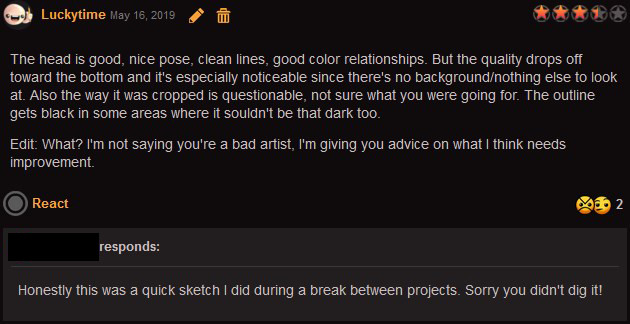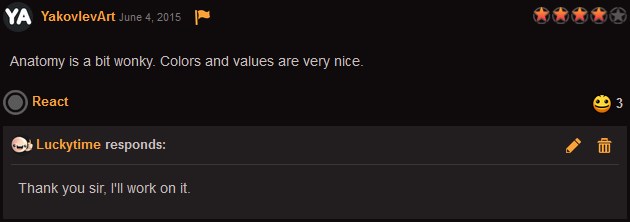INTRODUCTION
I'm writing this because you may or may not have seen one of my many art reviews around the site and wondered where I get my basis for grading artwork. At the very least, I hope you get a kick out of reading this. in this post I will break down why I give 5 stars to some drawings and not to others, and demystify the thought-process behind it.
PART 1: PURPOSE
One of my art teachers once told me something that forever changed the way I look at art. We had just finished our warm-up sketches and as I continued to push the quality of the cup I was drawing, I inquired about something that all artists struggle with at some point or another. I asked: "when can you call a drawing finished?" He responded with another question: "What is your drawing meant to be?" and then continued "If a drawing is meant to be a sketch and you're using it to loosen up before getting to the important stuff, then your drawing has served its purpose". This was a brand new concept to me at the time; assigning a function to a drawing BEFORE starting it was never something I considered until that moment. Needless to say, that stuck with me. More on this later.
PART 2: DISTINCTION
Here on Newgrounds, you have the option of submitting your art as a sketch, in which case it will not have a rating, or you can submit it to the portal, which is what most people do without thinking of the implications. I understand, there's an allure to the attention associated with your art being on display for the public to admire. However, the distinction between these two is important because one acknowledges the validity of a piece of artwork and the other doesn't. People can still leave a rating and review of your sketches, but the OVERALL rating is not displayed. The way I see it, this feature was meant for drawings that have been shelved and may never be completed, practice drawings, works-in-progress or anything else that doesn't show you putting your best foot forward. Unfortunately, hardly anyone uses this feature because the sweet, sweet call of attention is just too strong.
PART 3: CRITICISM
Newgrounds makes it very clear that we are not leaving comments, but REVIEWS. This is precisely why I may not hold back when reviewing the art you submit to the art portal. Even so, I still get replies on my reviews that show a fundamental lack of receptiveness to feedback, even if it's constructive. I believe it's important to illustrate this point so without naming-and-shaming, let's take a look at an example:

I may be reading too much into this response, but I don't think so. I think this person actually felt like I was attacking them in my review. Two things clued me in: 1. The artist didn't respond to any of their positive reviews, as if a positive review is to be expected. 2. They apologized to me, something which signifies that an error was made, or that a confrontation has taken place. I started with a list of things I LIKED about the drawing and gave it an above-average score, but it still wasn't good enough because we tend to demonize critical feedback instead of celebrating it as an opportunity to grow.
Now let's take a look at a healthy exchange:

Do you see the difference? I did not get defensive, I did not make excuses and I thanked the reviewer for taking the time to provide their perspective. Nobody on this site gets paid to sit around reviewing your artwork. Trust me, I wish I could. People are giving you their time for FREE so the least you can do is acknowledge when somebody goes the extra mile and looks at your art with a critical eye. You would normally have to shell out tuition to find out from a jaded, middle-aged art professor that your drawing sucks ass.
PART 4: FULFILLMENT
We already know about color-relationships, negative space and composition. Artists often talk about these things when they evaluate a drawing, but nobody discusses what the purpose of a drawing is, or why it even matters. Here is where my point comes full-circle. My ultimate theory which I use to grade art is this:
"An artwork is successful if, in its execution, no aspect therein, or lack thereof, dampens, diminishes, or in any way detracts from the unbridled realization of the raw vision that inspired the artist to commence it."
In other words: Does the art, whether it's a drawing or something else, live up to the purpose it was created for? Just as my art teacher asked me, does the sketch fulfill its purpose? That question is easier asked than answered. It's also equally important to ask whether the purpose is a worthy or noble one. This is very subjective and everyone must answer it for themselves. I try to be as unbiased as possible, but I'm human and flawed. That means that I might not see the purpose of a drawing when it may be clear as day to someone else.
PART 5: INTUITION
All of this begs the question: "If you don't know what the artist's original vision was, then how can you grade the outcome against it?" The answer to that question could be an entire blog-post of its own. Basically, it comes down to intuition. It comes from having seen thousands of successful and unsuccessful drawings and paying attention to the skill-level of the artists who made them, commentaries supplied by the artists, public responses and a whole slew of other minutiae. My thought-process when I see a drawing for the first few seconds is critical in forming my opinion of it. First, I immediately try to find obvious flaws. These stick out to a point where I can't ignore them, even if I tried. If I can't find any obvious flaws, I try to find subtle flaws. These don't necessarily make the drawing bad as long as they're offset by something else which makes them less relevant. I also take note of any obvious or subtle successes. I then take all of this information and combine it with my previous experience to form a theory about what the artist's raw vision may have looked like, and if they succeeded in recreating it.
PART 6: EXAMPLES
Because a drawing only needs to realize its purpose to be deemed successful in my eyes, It can be extremely minimal and derive its profundity from some deeper subtext. Here's an example of a drawing that I would say pulls this off perfectly:
While this drawing is not nearly as technically impressive as others, I feel like it absolutely nailed what it was intended to convey. I gave it 5 stars and I want you to remember that as you look at this next example:
I personally think this is an amazing drawing, but my precise review of this drawing does not matter. All that matters is that I wouldn't give it 5 stars. It's got much more going on than the previous example, but it engages in self-sabotage. What I mean is that because the artist included mountains next to the figure to give it a sense of scale, I am forced to consider how an object looks at a scale that huge, and my experience tells me that it doesn't look like that. There would be way more atmospheric diffusion if it was the size of a mountain. Therefore, I deduct points. That is only 1 flaw, but my point is that If the artist chose not to include mountains, that would've been 1 less flaw for me to notice.
CONCLUSION
Am I saying if you can't draw something then don't even bother? Absolutely not. On the contrary, you should try to draw as many challenging things as you can. That's the quickest way to improve. What I'm saying is that when an attempt is made, and the attempt fails, and you submit it to the portal regardless of whether or not you think it represents the best of your ability, then don't act surprised if you receive some critical feedback on it.
If you still don't understand, this may help: The Hitchhiker's Guide to Critique.





















